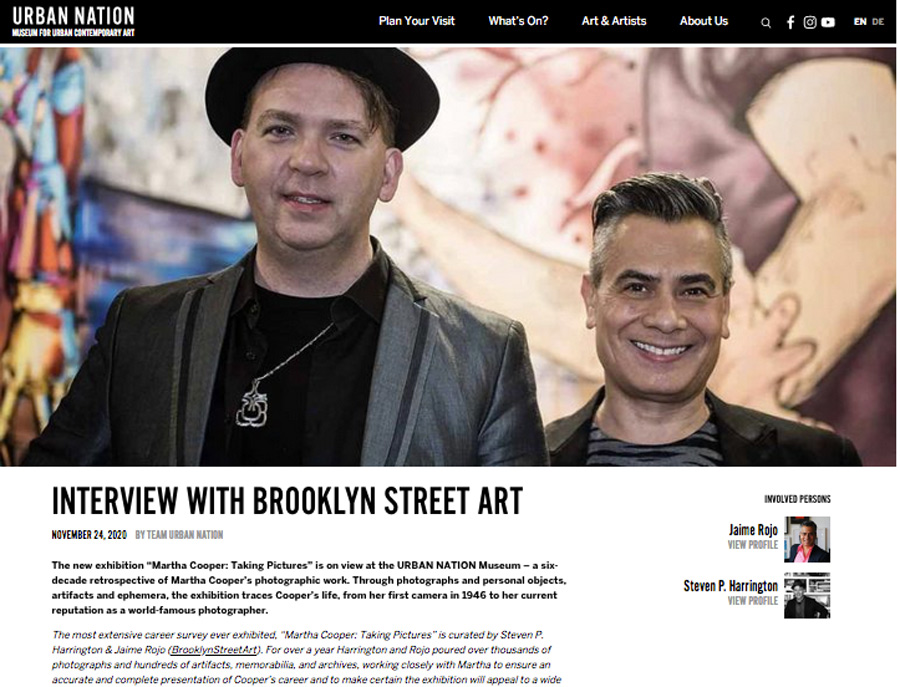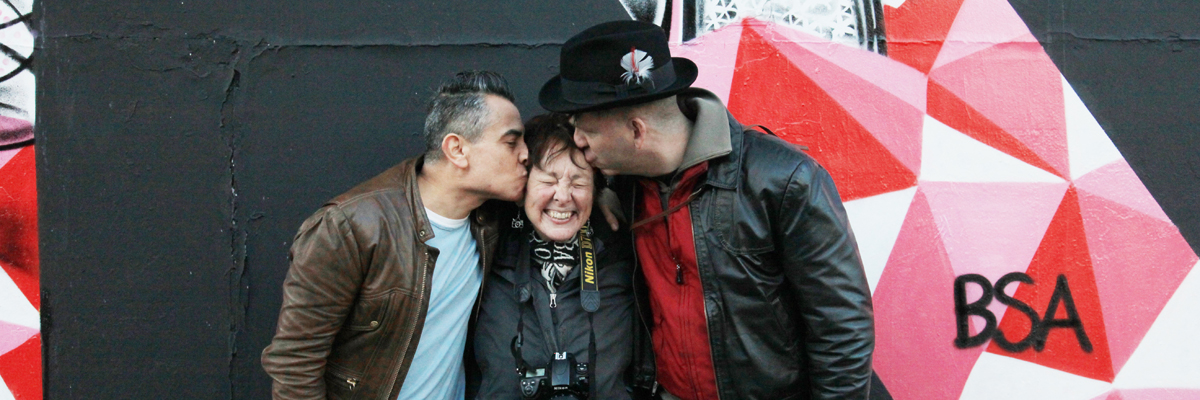The new exhibition “Martha Cooper: Taking Pictures” is on view at the URBAN NATION Museum – a six-decade retrospective of Martha Cooper’s photographic work. Through photographs and personal objects, artifacts and ephemera, the exhibition traces Cooper’s life, from her first camera in 1946 to her current reputation as a world-famous photographer.

The most extensive career survey ever exhibited, “Martha Cooper: Taking Pictures” is curated by Steven P. Harrington & Jaime Rojo (BrooklynStreetArt). For over a year Harrington and Rojo poured over thousands of photographs and hundreds of artifacts, memorabilia, and archives, working closely with Martha to ensure an accurate and complete presentation of Cooper’s career and to make certain the exhibition will appeal to a wide audience as well as her ardent fans equally. In an interview the two acclaimed curators talk about the challenges of planning a new exhibition and their relationship with Martha Cooper, giving a rare insight into the work of a curator and providing an inside look at selected highlights of the exhibition.

Steve and Jaime, you have been working as curators, writers and bloggers for many years. Please take us back to the beginning of your careers. How did you meet and when did you decide to work together as a team?
We met in the 1980s when we both came to New York as university students and we have been actively involved in a wide range of projects in the arts separately and together for the last three decades. From “Low” to “High” art, we’ve always relied on the intelligence of the street-based subcultures to tell us the future, and we’ve each found that a fully immersive approach is the best way to understand everything from aesthetics to the humanities to music to movements in media and popular culture. We also discovered that as a team we are both determined to do it 100%.
In the late 1990s and early 2000s we became captivated by the new wave of art on the streets in neighborhoods like Williamsburg, Brooklyn, where a booming artist community was reimagining and remixing cultures in the wake of radical economic shifts that were forcing the young creative communities off the island of Manhattan. Primarily art school students of one kind or another, these artists were using the platform of the New York streets to bypass a rigid gallery system and other “gatekeepers”– and they were of course influenced by the collective legacy of graffiti, pop culture, decades of being drenched in advertising, and the dawning of the Internet age. Not content to simply imitate graffiti culture, they were reinterpreting, reinterpolating, when translating concepts, techniques and history learned in formal education.
In short, it was the dawn of street art as we knew it and we were lucky to be living as artists/curators at one physical epicenter of it. Our neighborhood and social and professional circles included loosely organized groups of artists and collectives who created art parties and mounted interactive events in empty factory lofts or on rooftops or in basement speakeasies; art shows, theatrical events, djs, projections, video, performance, fashion, new music and a new merging of technology. We too were throwing loft parties and staging art events and performances, sometimes for hundreds of people, and it all seemed perfectly normal that art was spilling out into the streets as well.
These were all influencing factors that led us to self-publish our first street art book in 2006 with Steve’s words and with Jaime’s photographs of works by artists in our neighborhood. It was called Williamsburg Street Art: Unrestricted and it featured artists like Swoon, Faile, Banksy, Bäst, Shepard Fairy, Dan Witz, and DAIN – all of whom went on to show with major galleries and some who have had huge exhibitions in museums worldwide with great commercial and critical success. When we secured a proper publishing arrangement for our second book Brooklyn Street Art (Penguin/Random House) we started a small website to support it in March of 2008 under the same name. That first month we had 54 hits on the site. Later we would pass 100,000 per month.
Click HERE to continue reading the interview at Urban Nation Museum For Urban Contemporary Art Berlin.
Other Articles You May Like from BSA:
We're back in Bayonne today to look at more images from the Points de Vue festival hosted last month in the south of France. More varied disciplines are on display here than you may typically see at ...
Our weekly focus on the moving image and art in the streets. And other oddities. Now screening : 1. Tats Cru on the Houston Wall in NYC 2. Broken Fingaz Crew In Mexico: "Si Desaparezco Rompe ...
Street artist and muralist GAIA just finished a new tribute in Lexington, Kentucky with the PRHBTN gallery focused on a local colorful character named James Herndon, aka “Sweet Evening Breeze.” G...
MEETING OF STYLES had a huge event celebrating the 28th anniversary of the seminal book Spraycan Art by Henry Chalfant and James Prigoff in September in San Francisco. Organized by the community organ...
You made it! Thanksgiving is over and you did not explode from eating too much pumpkin pie. Right? A number of subverting artists and activists took over billboards in cities around the world this ...
 BROOKLYN STREET ART LOVES YOU MORE EVERY DAY
BROOKLYN STREET ART LOVES YOU MORE EVERY DAY










